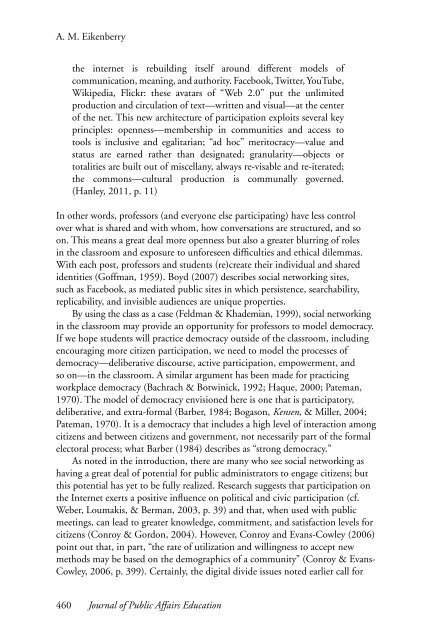summer 2012 - National Association of Schools of Public Affairs and ...
summer 2012 - National Association of Schools of Public Affairs and ...
summer 2012 - National Association of Schools of Public Affairs and ...
Create successful ePaper yourself
Turn your PDF publications into a flip-book with our unique Google optimized e-Paper software.
A. M. Eikenberry<br />
the internet is rebuilding itself around different models <strong>of</strong><br />
communication, meaning, <strong>and</strong> authority. Facebook, Twitter, YouTube,<br />
Wikipedia, Flickr: these avatars <strong>of</strong> “Web 2.0” put the unlimited<br />
production <strong>and</strong> circulation <strong>of</strong> text—written <strong>and</strong> visual—at the center<br />
<strong>of</strong> the net. This new architecture <strong>of</strong> participation exploits several key<br />
principles: openness—membership in communities <strong>and</strong> access to<br />
tools is inclusive <strong>and</strong> egalitarian; “ad hoc” meritocracy—value <strong>and</strong><br />
status are earned rather than designated; granularity—objects or<br />
totalities are built out <strong>of</strong> miscellany, always re-visable <strong>and</strong> re-iterated;<br />
the commons—cultural production is communally governed.<br />
(Hanley, 2011, p. 11)<br />
In other words, pr<strong>of</strong>essors (<strong>and</strong> everyone else participating) have less control<br />
over what is shared <strong>and</strong> with whom, how conversations are structured, <strong>and</strong> so<br />
on. This means a great deal more openness but also a greater blurring <strong>of</strong> roles<br />
in the classroom <strong>and</strong> exposure to unforeseen difficulties <strong>and</strong> ethical dilemmas.<br />
With each post, pr<strong>of</strong>essors <strong>and</strong> students (re)create their individual <strong>and</strong> shared<br />
identities (G<strong>of</strong>fman, 1959). Boyd (2007) describes social networking sites,<br />
such as Facebook, as mediated public sites in which persistence, searchability,<br />
replicability, <strong>and</strong> invisible audiences are unique properties.<br />
By using the class as a case (Feldman & Khademian, 1999), social networking<br />
in the classroom may provide an opportunity for pr<strong>of</strong>essors to model democracy.<br />
If we hope students will practice democracy outside <strong>of</strong> the classroom, including<br />
encouraging more citizen participation, we need to model the processes <strong>of</strong><br />
democracy—deliberative discourse, active participation, empowerment, <strong>and</strong><br />
so on—in the classroom. A similar argument has been made for practicing<br />
workplace democracy (Bachrach & Botwinick, 1992; Haque, 2000; Pateman,<br />
1970). The model <strong>of</strong> democracy envisioned here is one that is participatory,<br />
deliberative, <strong>and</strong> extra-formal (Barber, 1984; Bogason, Kensen, & Miller, 2004;<br />
Pateman, 1970). It is a democracy that includes a high level <strong>of</strong> interaction among<br />
citizens <strong>and</strong> between citizens <strong>and</strong> government, not necessarily part <strong>of</strong> the formal<br />
electoral process; what Barber (1984) describes as “strong democracy.”<br />
As noted in the introduction, there are many who see social networking as<br />
having a great deal <strong>of</strong> potential for public administrators to engage citizens; but<br />
this potential has yet to be fully realized. Research suggests that participation on<br />
the Internet exerts a positive influence on political <strong>and</strong> civic participation (cf.<br />
Weber, Loumakis, & Berman, 2003, p. 39) <strong>and</strong> that, when used with public<br />
meetings, can lead to greater knowledge, commitment, <strong>and</strong> satisfaction levels for<br />
citizens (Conroy & Gordon, 2004). However, Conroy <strong>and</strong> Evans-Cowley (2006)<br />
point out that, in part, “the rate <strong>of</strong> utilization <strong>and</strong> willingness to accept new<br />
methods may be based on the demographics <strong>of</strong> a community” (Conroy & Evans-<br />
Cowley, 2006, p. 399). Certainly, the digital divide issues noted earlier call for<br />
460 Journal <strong>of</strong> <strong>Public</strong> <strong>Affairs</strong> Education

















